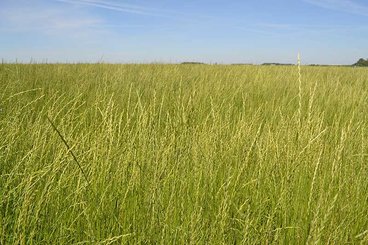
Perennial Progress at University of Minnesota
University of Minnesota Forever Green Initiative marks major milestone in its development of next generation, earth-friendly crops
Minnesotans are recognized for taking pride in caring for their state’s land and water. Starting today, a select group of Minnesota farmers will have the opportunity to take a considerable next step in making production agriculture an even stronger tool for land and water stewardship and economic development -- while bringing environmental benefits to modern farms and consumers’ diets.
A new Kernza® variety is being released to a limited number of select qualified growers in the state under the name “MN-Clearwater.” Kernza is a new perennial grain being developed by the University of Minnesota’s Forever Green Initiative and The Land Institute.
The variety name MN-Clearwater stems from early research showing the significant potential benefits of Kernza for water quality. This is the first official variety of Forever Green’s many new crops in development to be released to Minnesota growers. Forever Green innovates across many areas of multiple crops and cropping systems, including extensive work in agronomy, food science and environmental impact.
“The release of MN-Clearwater is a major milestone in our mission to develop the next generation of crops,” said Donald Wyse, Ph.D., professor in the university’s College of Food, Agriculture and Natural Resource Sciences’s Department of Agronomy and Plant Genetics,and lead scientist for Forever Green. “This is a key step to offering new economic opportunities to Minnesota farmers and rural communities while reaping significant potential benefits for the environment.”
Kernza is the world’s first commercially-viable perennial grain. Its deep root system -- which can extend 10 feet or more beneath the soil surface -- has greater density and is more extensive than annual wheat roots, allowing it to capture more applied fertilizer and reduce total nitrate leaching by 86 percent or more relative to annual wheat.
Working together, The Land Institute and Forever Green are breeding IWG (Thinopyrum intermedium) for increased seed yield and other improved traits so it can be used as a perennial grain crop.
By providing year-round soil coverage over multiple years and uniquely large belowground carbon inputs from roots, farmers growing MN-Clearwater can benefit the environment with the ability to:
- Reduce nitrogen and phosphorus contamination of freshwater and marine ecosystems
- Reduce weed competition
- Minimize the need for tillage or herbicide applications
- Reduce greenhouse gas emissions
- Sequester more carbon
“Today’s consumers are looking for foods that are wholesome, great-tasting and environmentally-friendly,” said Jacob Jungers, Ph.D, Assistant Professor at the University of Minnesota Department of Agronomy and Plant Genetics. “Research has shown that using continuous soil cover, farmers can greatly reduce soil erosion, potentially turning agriculture into a soil-forming ecosystem, much like the natural ecosystems it replaced. That’s good for the environment, farmers and the people who enjoy a variety of food products from the crop.”
“Having Minnesota growers in targeted areas plant Kernza MN-Clearwater is an important step forward, as this new variety shows an average of 25 percent higher yield and reduced lodging compared with available IWG materials,” said James Anderson, Ph.D., professor of wheat breeding and genetics at the University of Minnesota. MN-Clearwater resulted from an 8 year breeding, testing, and seed increase process in Minnesota environments that was initiated from germplasm provided by The Land Institute.
“We are eager to form several small teams of farmers and other key partners to maximize the chances for new plantings to succeed on the farm and eventually in larger scale in the commercial market,” Wyse said. “For the long-term success of this important crop, we’re taking a thoughtful approach as we work toward the substantial economic and environmental benefits it can offer to Minnesota, the U.S. and the world.”
The University of Minnesota’s Forever Green Initiative
The University of Minnesota’s Forever Green Initiative (UMFGI) mission is to diversify economic opportunities for Minnesota’s farmers through the production of new sources of food, feed, and high-value biomaterials without interfering with current annual production systems. Teams of faculty working on breeding, agronomics, ecology, food science and economics are developing new crops such as intermediate wheatgrass (Kernza® varieties) to improve vital land and water resources; and, enable abundant grain production despite climate variability and new pest pressures. The new Forever Green crops will enhance rural communities by creating new industries and employment opportunities based on renewable agriculture resources. Visit forevergreen.umn.edu to learn more.
The Land Institute
The Land Institute is a 501(c)(3) non-profit organization based in Salina, Kansas, that was founded in 1976. The Land Institute’s work, led by a team of agronomists and ecologists in multiple partnerships worldwide, is focused on developing perennial grains, pulses and oilseed bearing plants to be grown in ecologically intensified, diverse crop mixtures known as perennial polycultures. The Land Institute’s goal is to create an agriculture system that mimics natural systems in order to produce ample food and reduce or eliminate the negative impacts of industrial agriculture. Visit landinstitute.org to learn more.
About the College of Food, Agricultural and Natural Resource Sciences
The University of Minnesota College of Food, Agricultural and Natural Resource Sciences brings science-driven innovators together to discover hands-on solutions to global challenges. With ten research and outreach centers across Minnesota, the Minnesota Landscape Arboretum and the Bell Museum of Natural History, CFANS offer unparalleled experiential learning opportunities for students and the community. Learn more at cfans.umn.edu.






